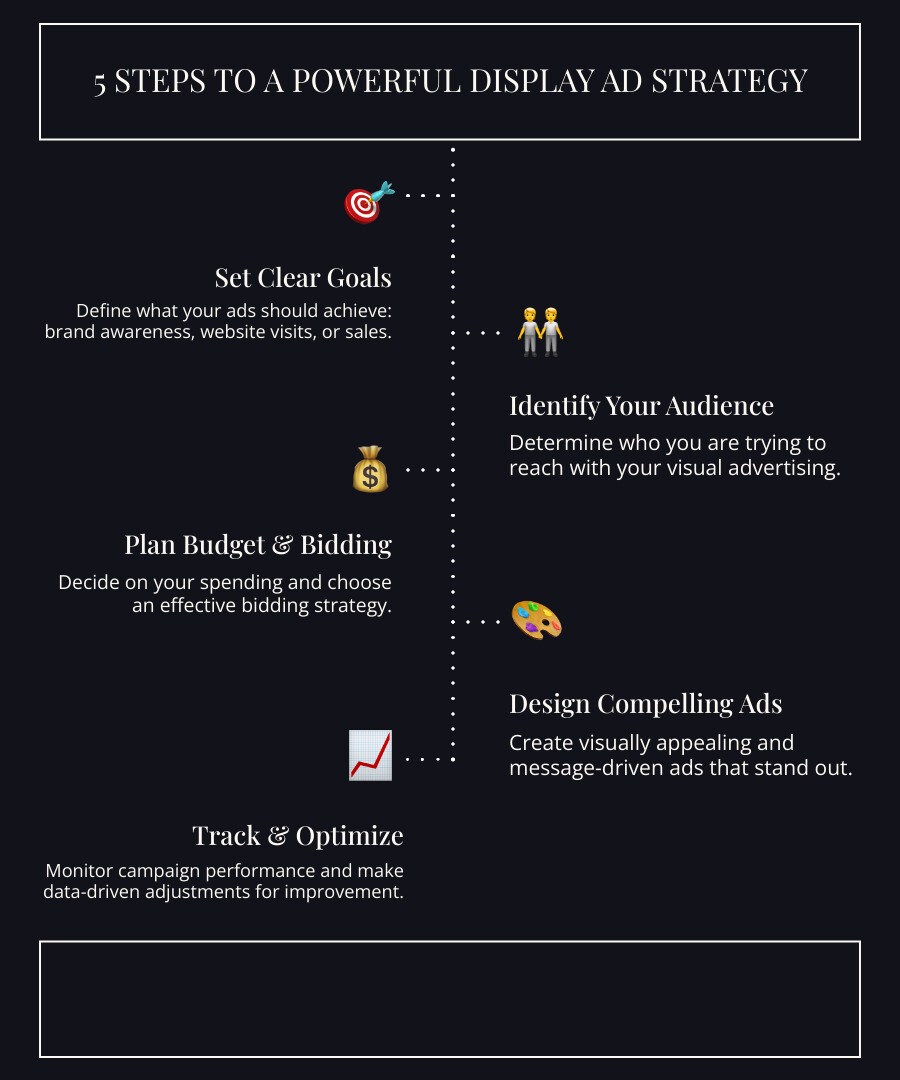Why a Powerful Display Advertising Campaign Strategy Matters
A strong display advertising campaign strategy helps businesses reach new customers and grow their brands. To build a successful plan, focus on these key steps:
- Define clear goals: What do you want your ads to achieve? (e.g., brand awareness, website visits, sales)
- Identify your audience: Who are you trying to reach?
- Set your budget: How much will you spend, and what bidding strategy will you use?
- Design compelling ads: Create visuals and messages that get noticed.
- Track and improve: Watch your results and make changes to do better.
Display advertising shows your visual ads to people as they browse online. It puts your brand in front of potential customers, even if they aren't actively searching for you. This builds brand recognition and connects you with a wide audience. With global digital ad spending expected to hit $836 billion by 2026, having a smart plan is more important than ever.
This guide will help you create a clear, effective display ad strategy.
I'm Steve Pogson, a Shopify Expert and E-commerce Growth Specialist with over two decades of experience helping online businesses succeed. I'm passionate about scaling Shopify stores through a full e-commerce ecosystem, which includes a strong display advertising campaign strategy.

Display advertising campaign strategy terms you need:
- how to create a successful digital marketing campaign
- campaign management in digital marketing
- how to measure the effectiveness of a digital marketing campaign
Understanding the Basics: What Are Display Ads?
Display ads are the visual promotions you see on websites, apps, and social media. Think of them as digital billboards for products, services, or brands.
Display advertising is a "push" approach, putting your message in front of people even if they aren't actively searching for it. This contrasts with search advertising, a "pull" strategy where ads appear when someone is already looking for a solution. Display ads are great for building awareness and interest.
Display ads face challenges like "banner blindness" (people ignoring ads) and ad blockers. Poorly targeted ads can also waste money. Despite this, with global digital ad spending projected to hit $836 billion by 2026, a well-planned display advertising campaign strategy is vital. A strong Digital Advertising Strategy is key.
Key Benefits of Display Advertising
Despite the challenges, display ads offer huge benefits for business growth.
- Increase brand awareness: Consistently showing your ads makes your brand familiar to a large audience. This is key for Brand Awareness in E-commerce, helping customers remember you when they're ready to buy.
- Target customers precisely: Show ads to specific groups based on age, interests, or online behavior. This ensures your ads reach the most relevant people, making your budget more effective. You can use tools like In-Market and Affinity Audience data for even better targeting.
- Support full-funnel campaigns: Use display ads at every stage of the customer journey, from introducing your brand to encouraging a purchase.
- Retarget customers: Show ads to people who have already visited your site. These reminders can bring interested visitors back to complete a purchase. Retargeting is highly effective, with some campaigns seeing a 70% higher conversion rate. Learn more about retargeting solutions.
- Measure results easily: Track impressions, clicks, sales, and return on ad spend (ROAS). This data helps you see what's working so you can improve your strategy. This makes it a smart investment and a key part of successful Online Advertising in E-commerce.
Common Ad Formats and Types
When planning your display advertising campaign strategy, you have many ad format choices. The best one depends on your campaign goals and audience.
Here are some common ad formats:
- Banner Ads: These classic rectangular image ads appear on webpages. They're great for brand visibility and driving website traffic.
- Responsive Display Ads (RDAs): Upload your assets (images, headlines, logos), and Google automatically creates ads that fit any ad space. This saves time and ensures your ads look great everywhere.
- Native Ads: These ads blend in with the surrounding content, making them less intrusive and more effective at grabbing attention.
- Video Ads: Short video clips that play in display ad spots. They are great for storytelling and showing products in action, often getting more clicks than static images.
- Rich Media Ads: Interactive ads with elements like video, sound, or games. They encourage user involvement and typically perform better than static ads.
Beyond formats, consider ad delivery. Many display ads now use programmatic advertising, an automated system for buying ad space in real-time. It allows for precise targeting and optimized delivery. When you plan your Google Display Ads, considering these options helps you create the right mix to meet your goals.
Building Your Blueprint: A 5-Step Display Advertising Campaign Strategy
A successful display advertising campaign strategy needs a clear plan, like a blueprint for a house. I break it down into five key steps, covering your goals, audience, budget, and ad placements.
Step 1: Set Clear Goals and Define Your Audience
This is the foundation of your campaign. First, you need to know why you're running ads and who you're trying to reach.
First, define your goals. Do you want brand lift or awareness (getting your name out there) or conversions (like sales or sign-ups)? Each goal has different Key Performance Indicators (KPIs) to measure success. For sales, a key KPI is profit. Document your goals in a Campaign Brief.
Next, know your audience. Get specific about their demographics (age, location), interests, and online behaviors. For instance, a hiking gear company should target outdoor lovers. Use tools like In-Market and Affinity Audience targeting to find people already interested in your products. You can also use contextual targeting, placing ads on relevant websites (e.g., a hiking ad on a travel blog). If your audience is too small, you can broaden your reach by exploring similar groups.
Step 2: Plan Your Budget and Bidding
With your goals and audience defined, it's time to plan your budget. Decide how much to spend and how to make it work effectively.
Your budget should line up with your goals. Brand awareness may require a larger budget than a targeted sales campaign. You have several payment options, and understanding them is key to a profitable display advertising campaign strategy.
Here's a quick look at how you might pay for your ads:
| Billing Model | Primary Goal | What I Pay For |
|---|---|---|
| Flat Rate | Fixed Cost | Agreed-upon placement for a set period |
| Cost Per Mille (CPM) | Brand Awareness | Every 1,000 ad impressions (views) |
| Cost Per Click (CPC) | Website Traffic | Every time someone clicks my ad |
| Cost Per Lead (CPL) | Lead Generation | Every time a qualified lead is generated |
| Cost Per Sale (CPS) | Direct Sales/Conversions | A percentage or fixed amount per sale |
CPA (Cost Per Acquisition) is what you pay for a specific action. Many platforms offer automated bidding to optimize spending for goals like sales or a better ROAS (Return on Ad Spend). Tools like Google's Performance Planner can help forecast results based on different budget scenarios, helping you Increase ROI on E-commerce Ad Spend.
Step 3: Choose Your Ad Placements
Where your ads appear is as important as their design. It's like choosing the right location for a billboard.
Large ad networks like the Google Display Network (GDN) reach millions across websites and apps. Social media networks like Facebook and Instagram are also great for visual ads, which you can learn about in Paid Social Advertising. Don't overlook mobile apps, especially games, as prime ad spots.
Use whitelists (approved sites) and blacklists (banned sites) to control where your ads appear. This protects your brand and improves performance by ensuring ads show only on relevant, brand-safe sites. You can also exclude geographic areas if needed.
Creating Ads That Connect: Design and Messaging Best Practices

Even with perfect targeting and budget, ads must connect with the audience. With an average attention span of just 8 seconds, every detail in your ad matters.
How to plan your display ad creative
Your ad creative should be visually appealing, clear, and action-oriented. Here’s a planning guide:
- Keep Designs Simple: Cluttered designs overwhelm viewers and reduce involvement. Aim for clean, simple visuals that communicate your message quickly.
- Use Strong Visual Hierarchy: Guide the viewer's eye. The most important elements—logo, product, headline, CTA—should stand out immediately.
- Use Quality Visuals: Use high-quality, relevant images. Images showing the product in use help customers visualize it. For responsive ads, avoid text within images, as it can get distorted.
- Write Compelling Copy: Keep copy concise and focused on benefits. Emphasize your unique value proposition. For example, instead of "Our Software," try "Streamline Workflows and Boost Team Productivity." Make the value clear and relevant.
- Have a Clear Call-to-Action (CTA): Tell people what to do next. Use direct, action-oriented phrases like "Shop Now" or "Sign Up." Make the CTA button stand out.
- Maintain Consistency: Your ad's message and design must match its landing page. If an ad promises a 20% discount, the landing page should immediately emphasize that offer. Inconsistency leads to high bounce rates.
- Test Different Formats: Create variations for different Google Display Ad Sizes and formats (static, animated, responsive). A/B testing is crucial to find what works best.
Optimizing for Mobile and Interactive Experiences
With most online traffic now on mobile, optimizing your ads for mobile is essential.
- Use Responsive Design: Ads must adapt to different screen sizes. Poorly optimized ads look bad on mobile and lead to low involvement and wasted spend. Mobile-optimized ads can boost conversion rates significantly.
- Boost Involvement with Interactivity:
- Rich Media: Use interactive ads with elements like carousels or forms. They drive higher user involvement and offer better performance tracking.
- Animated Ads: HTML5 animations can show more information than static ads and are often more involving. They also have small file sizes.
- Video Ads: Short videos are effective, especially on YouTube. Viewers often prefer them to static ads. You can use them for your YouTube Ad Campaign. Be mindful of audio, as most users find loud, unexpected sound annoying.
Advanced Tactics: Using Data to Increase Performance
Once your ads are live, the work continues. An effective display advertising campaign strategy uses data to get smarter. This means continuous monitoring, data analysis, and optimization to increase results. You'll also need to adapt to privacy changes. This is how you refine campaigns for maximum impact and ROI.
Using Remarketing to Increase Performance
Remarketing, also called retargeting, is a game-changing tactic. (Learn more in our Glossary: Retargeting). It’s about reconnecting with people who have already shown interest in your brand.
It works by showing targeted ads to previous website visitors, including cart abandoners. These ads act as a friendly reminder. First Pier offers Retargeting Solutions to help businesses use this tactic.
It's powerful because these users are already familiar with your brand and closer to buying. Remarketing can lead to much higher click-through and conversion rates while lowering costs. Its efficiency can be over 1,000% higher than other ad strategies.
Adapting to privacy changes like the third-party cookie phaseout is crucial. Traditional tracking methods are changing, but new solutions are available. For example, Google’s Protected Audience API allows for remarketing while protecting user privacy. Staying updated on these changes keeps your campaigns compliant and effective.
Using Dynamic Creative Optimization (DCO)
Dynamic Creative Optimization (DCO) is a technology that delivers personalized ad variations to users in real-time.
Instead of creating hundreds of ads manually, DCO uses data (like browsing history or location) to assemble the most relevant ad for each person. For example, a user might see an ad for the exact shoes they just viewed, creating personalized product recommendations.
DCO can pull information from your product feed, which is great for e-commerce with Dynamic Feed Ads. Ads update automatically if a price changes or a product goes out of stock, ensuring accuracy through real-time adjustments.
DCO also automatically tests different ad combinations (headlines, images, CTAs) to find what works best for different audiences. This automated creative optimization improves performance without constant manual work.
Measuring What Matters: Key Metrics for Success
Launching a display advertising campaign strategy is just the start. You need to track key metrics to understand what's working and where you can boost performance.
Here are the essential metrics to track:
- Impressions: The number of times your ad was shown. This measures reach and visibility.
- Clicks: The number of times users clicked your ad, indicating interest.
- Click-Through Rate (CTR): Clicks divided by impressions. This percentage shows how compelling your ad is. A typical display CTR is 0.1% to 0.5%.
- Conversions: The number of users who completed a desired action (like a purchase or sign-up) after clicking your ad.
- Cost Per Acquisition (CPA): The cost to acquire one customer (Total Spend / Conversions). The goal is to lessen CPA while maintaining quality. Track this with Marketing Attribution Reporting.
- Return on Ad Spend (ROAS): The revenue generated for every dollar spent on ads (Revenue / Ad Spend). This directly measures profitability.
- Viewability Rate: The percentage of your ad impressions that were actually viewable (at least 50% on screen for one second). Since you pay for impressions, you want them to be seen. Focus on sites with high viewability to boost performance and ROI.
Don't look at these metrics in isolation. Analyze them together, lining them up with your marketing funnel stages. This full approach helps guide optimizations. You can also learn How to Measure the Effectiveness of a Digital Marketing Campaign more broadly.
Frequently Asked Questions about Display Ad Campaigns
I often get asked common questions about display ad campaigns. Here are some answers to help clarify things.
What makes a display ad campaign successful?
A successful display advertising campaign strategy needs the right mix of ingredients. It starts with clear goals: Are you aiming for brand awareness, website traffic, or sales? Your goal guides all other decisions.
Next, use precise audience targeting to reach people who are genuinely interested. Your ad creative must be visually appealing and clear to grab attention. Finally, monitor your results, learn from the data, and continuously test and adjust your campaign. Success comes from how all these pieces work together.
How much should I spend on a display advertising campaign?
There's no single answer to this question. Your budget depends on your business, goals, and scale. I recommend starting with a test budget you're comfortable with. This lets you gather data without a huge investment.
Pay close attention to your Return on Ad Spend (ROAS) and Cost Per Acquisition (CPA). If your campaigns are profitable with a good ROAS, you can gradually increase your spending. Digital advertising is flexible, allowing you to start small and grow.
How is display advertising different from search advertising?
This is a key difference. Think of it this way:
Display advertising is a “push” strategy. It's like seeing a billboard in a mall; you weren't looking for it, but it caught your eye. We show visual ads to people as they browse online to build brand awareness and create interest for products they aren't actively searching for.
Search advertising is a “pull” strategy. It's like going to a store to buy specific shoes. When someone searches online, they have a need. Our ads appear in the search results to provide a solution. It's about capturing existing demand. Both strategies are important and work differently.
To Sum Up: Your Next Steps
Building a strong display advertising campaign strategy blends creativity with smart, data-driven planning. We've covered the basics, the key steps from goals to placements, and how to create ads that connect. We also looked at mobile optimization and advanced tactics like remarketing and DCO.
Here are the key takeaways:
- Have a clear purpose: Know your goals and your audience from the start. This sets the stage for success.
- Focus on creative: Good-looking ads with a clear message are crucial for standing out.
- Let data be your guide: Monitor your results and use the data to test ideas and make smart choices.
- Be ready to adapt: The digital world is always changing. Being ready to adapt and develop will keep you ahead.
Great results take time, patience, and persistence. It's okay if your first attempts aren't perfect. The real win is in continuous improvement, testing, and learning.
If you need help with your display advertising campaign strategy, my team at First Pier is here for you. We specialize in helping brands, particularly with Shopify development, build strong online businesses. Based in Portland, Maine, we enjoy helping e-commerce owners succeed.
Let's begin exploring how we can help you develop your marketing campaign strategy with our team.









